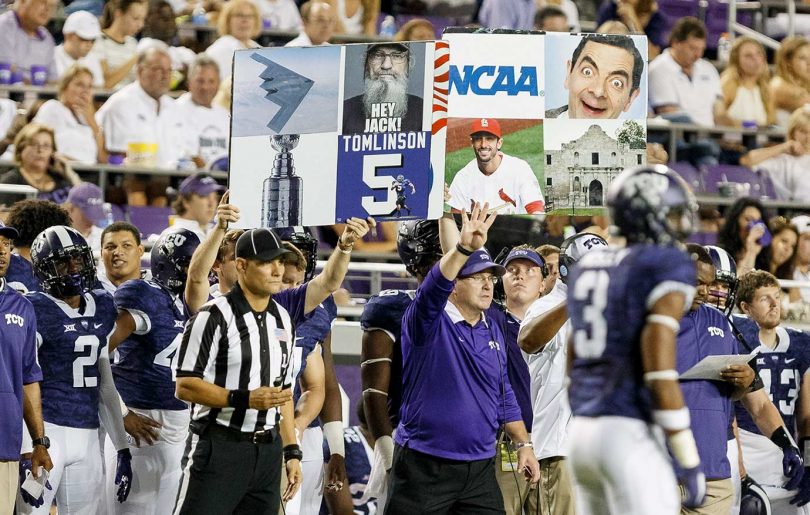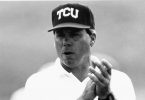Tin foil hat
A hat made from one or more sheets of aluminum foil worn in the belief that it shields the brain from threats of electromagnetic fields and mind control. The notion of wearing a tin foil hat has become a popular stereotype for paranoia, persecutory delusions and belief in conspiracy theories.
Of all the cranial accouterments worn by football coaches – Steve Spurrier’s jaunty visor, Les Miles’ white ball cap, Tom Landry’s stylish fedora, among them – none comes in more one-size-fits-all models than the head coach’s tin foil hat.
Long before today’s men in charge began sweeping their practice fields for covert GoPro cameras, the great Landry was convinced that that infernal Beelzebub from Washington, George Allen, was spying on the Cowboys practices from the window of an adjoining Days Inn.
Though a God-fearing man, Landry, a former punter, didn’t trust Allen as far as he could kick him.
The late, great sports writer Frank Luksa once quoted Cowboys running back Walt Garrison about the problem:
“Any helicopter that came over, the coaches would look up and say, ‘Damn, there’s George Allen again, up there with a notebook.’”
Thus, here we were sitting in a TCU meeting room this week, asking questions to a head coach who shreds the contents of the garbage pails after each Horned Frogs practice.
Of all the quirky nuances of Gary Patterson, TCU’s successful and well-nuanced coach, none is more fun to prod and observe than his conviction that there’s a snake under every rock.
It’s been a tough year for Patterson and his team. The Frogs stand 4-6 with a difficult visit to Baylor awaiting them Saturday morning.
“Twenty major surgeries, another 16 guys that have missed at least four games . . . ,” Patterson said, repeating the season’s now-familiar medical litany.
“You think 36 guys out of 85 scholarships and close to half have missed at least four games. Twenty season-ending injuries.
“The reason I tell you is I think the kids deserve credit, for the simple reason that they’ve fighting their tails off.”
Though the many injuries seem to validate the Horned Frogs’ sudden vulnerabilities, Patterson raised media brows Tuesday by announcing that a complete systems overhaul might be in order.
“We’re going to go back, and we’re going to have to have some conversations about what we need to do to be able to compete and play at a high level,” Patterson revealed.
“The way you should change your program is to always ask, ‘How do you beat the teams at the top?’ . . . Offensively, how can we change it, and defensively, too, because we’re not shutting out anybody else? How do you tweak things so you can become a better football team?”
Patterson referenced the 2014 season, when he brought in Sonny Cumbie and Doug Meacham to make over the offense to Oklahoma standards.
So what was Patterson saying Tuesday, exactly? That he thinks his team needs another new offense?
“I’m not saying that,” he answered. “I just think you have to be able to look at how you’re doing things.”
Patterson wasn’t worried about his team’s plays, he explained. He was worried about teams stealing the signals that sent in those plays.
A lengthy conspiracy monologue ensued. Call it the Seven Degrees of Kenny Perry. The former Frogs assistant coach (2013-14) now works with a guy who worked with a guy that coached with another guy who once shared a cab with Sonny Dykes and “had three guys watching my signals at SMU when we played them.”
(Cue the Twilight Zone music here).
“There are people stealing signals,” Patterson said.
“It’s been 21 years. It’s probably time to revamp, especially defensively, how we call everything.”
I can’t vouch for the Kenny Perry grassy knoll connection, but Patterson is undeniably right about the signal stealing.
Not all that long ago, it was easy to get a play called. The coach would shout into the ear of a receiver, and the receiver would run onto the field and tell the quarterback the play.
But college teams began running no-huddle, hurry-up offenses in an attempt to thwart the substitution patterns of opposing defenses. Teams would hustle to the line of scrimmage, pause and look to their sideline, where somebody/something would show them the play call.
Sometimes the play is being signaled by a specific coach or backup player. Other times, it could be from one of those big sign boards with pictures of Yosemite Sam or (a personal favorite) the poop emoji on them.
As Patterson describes it, teams are studying opponents’ play calling patterns and cracking the signal code.
A little paranoid there, coach?
Consider this from another college head coach:
“Stealing signals is one of the biggest issues in college football today.”
The man in the tin foil hat who said that?
Alabama’s Nick Saban.
Coaches have long feared roving eyes who could spy on a practice. The current Cowboys allow the media to watch only the opening few minutes of practices, usually the stretching period.
When Dick Vermeil coached the Philadelphia Eagles, he once stopped a playoff practice because he thought someone was spying on his team from the Goodyear blimp.
Saban, of all people, should know about signal-stealers. With carte blanche to hire at will at Alabama, Saban could afford to have a dozen spies in the press box, searching for clues. Guys around the country who are especially good at stealing signs are said to be in high demand.
“The first thing to do is see which side the visiting team’s bench is,” a former “offensive assistant” told me. “If the visitors are sitting across from the press box, you can book it – the home team is stealing signals.”
Forget the big cards, the former assistant said. Those are usually diversions, though sometimes they can signal tempo or some special play or blitz.
With multiple people on the sideline, all giving signals, the first thing a signal thief has to do is figure out which signaler is the real one.
“If it’s a player, it was never a second-string player because he might have to go in the game,” the assistant said. “So during warmups we would look to see which backup guys had their uniforms tricked up – like wearing three wristbands, or a white ballcap. Once the game began, the ‘hot’ guy might put a towel around his neck or he’d stand apart from the group.”
Sometimes it just took teamwork. TCU fans can try this Saturday.
Look at the sideline and count how many guys appear to be giving signals. If a guy is still giving signals when his quarterback suddenly turns his head back to the snapper, he isn’t the real signaler.
The same goes for stealing defensive signals, though I have no clue how Patterson, who gestures and semaphores signals throughout the game, is calling his defenses.
“Even in the game Saturday [in West Virginia], as soon as I called a certain blitz, here came the fly sweep — every time,” he said.
Of course, this would all be a lot easier if college football allowed what the NFL does – one-way radio helmets for the quarterback and one defensive player. The speaker in the quarterback’s helmet cuts off when the play clock gets to 15 seconds.
Why doesn’t the NCAA allow headset helmets?
“Financial,” Patterson said. “It’s a lot of money to get where you can get closed circuit that somebody can’t steal.”
That’s right. Perhaps in violation of several federal laws, teams have experimented with stealing opponents’ radio signals, should the helmets ever be allowed.
“You know how many times, even on the headsets we have now, where they won’t work in certain stadiums?” Patterson said. “Where you try to talk, and instead you get the airport or some radio station?
“We used to use a hard line. Now we’ve got wireless. But there are places in our stadium where I can stand and they go blank.”
It seems inevitable, though, that college football will allow the radio headgear at some point.
As Saban himself wondered, “Why are we 20 years behind the NFL in putting a device in the quarterback’s helmet?”
My friend, the former signal stealer, thinks the cost issue is a crimson herring.
“For one thing it’s loud in a lot of college stadiums,” he said. “Coaches don’t trust that their guy is going to hear the call every time.
“The other thing is that somebody would still have to signal the pass routes to the wideouts. And we’d steal that.”
For TCU’s Patterson, meanwhile, there’s going to be work to do when the season ends. Defenses will have to be renamed, he said. If the Frogs have a play book – Patterson is so furtive, nobody I know has ever seen one – it will have to be rewritten.
Paranoid? All football coaches are paranoid. The tin foil hats come in all sizes.
As Patterson said Tuesday, “Don’t get me wrong. We steal signals, too.”







